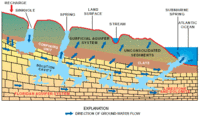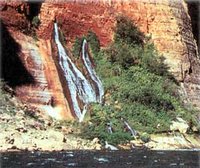Spring
Contents
Introduction
A spring is a water resource formed when the side of a hill, a valley bottom or other excavation intersects a flowing body of groundwater (Spring) at or below the local water table, below which the subsurface material is saturated with water. A spring is the result of an aquifer being filled to the point that the water overflows onto the land surface. They range in size from intermittent seeps, which flow only after much rain, to huge pools flowing hundreds of millions of gallons daily.
Springs are not limited to the Earth's surface, though. Recently, scientists have discovered hot springs at depths of up to 2.5 kilometers in the oceans, generally along mid-ocean rifts (spreading ridges). The hot water (over 300 degrees Celsius) coming from these springs is also rich in minerals and sulfur, which results in a unique ecosystem where unusual and exotic sea life seems to thrive.
The formation of springs
Springs may be formed in any sort of rock. Small ones are found in many places. In Missouri (United States), the largest springs are formed in limestone and dolomite in the karst topography of the Ozarks (Figure 1). Both dolomite and limestone fracture relatively easily. When weak carbonic acid (formed by rainwater and carbon dioxide) enters these fractures it dissolves bedrock. When it reaches a horizontal crack. crevice or a layer of non-dissolving rock such as sandstone or shale, it begins to cut sideways. As the process continues, the water hollows out more rock, eventually creating airspaces, the largest of which are known as caves or caverns. This process frequently takes tens to hundreds of thousands of years to complete.
Water flow from springs
The amount of water that flows from springs depends on many factors, including the size of the crevices or caverns within the rocks, the water pressure in the aquifer, the size of the spring basin, and the amount of rainfall. If the groundwater is under sufficient pressure, the spring (or a well) might shoot water into the air-artesian well or spring. Human activities also can influence the volume of water that discharges from a spring—groundwater withdrawals in an area can reduce the amount of water and the pressure in an aquifer, causing water levels in the aquifer system to drop and ultimately decreasing the flow from the spring. Most people probably think of a spring as being like a pool of water—and normally that is the case. But, as this picture of the wall of the Grand Canyon in Arizona, USA shows, springs can occur when geologic, hydrologic, or human forces cut into the underground layers of soil and rock where water is in movement (Figure 2).
Water quality in springs
Water from springs usually is remarkably clear. Water from some springs, however, may be "tea-colored" due to enrichment caused by groundwater coming in contact with naturally occurring minerals or organic material. If surface water enters the aquifer near a spring, the water can move quickly through the aquifer and discharge at the spring vent. The discharge of highly colored water from springs can indicate that water is flowing quickly through large channels within the aquifer without being filtered through the soil.
The quality of the water in the local groundwater system will generally determine the quality of spring water. The quality of water discharged by springs can vary greatly because of factors such as the quality of the water that recharges the aquifer and the type of rocks with which the groundwater is in contact. The rate of flow and the length of the flowpath through the aquifer affects the amount of time the water is in contact with the rock, and thus, the amount of minerals that the water can dissolve. The quality of the water also can be affected by the mixing of freshwater with pockets of ancient seawater in the aquifer or with modern seawater along an ocean coast.
The water is crudely filtered in the rock, and the time spent underground allows debris and mud to fall out of suspension. If underground long enough, lack of sunlight causes most algae and water plants to die. However, microbes, viruses, and bacteria do not die just from being underground, nor are any agricultural or industrial pollutants removed.
Thermal springs
A thermal spring, also known as a hot spring, is natural discharge of groundwater having an elevated temperature. Most hot springs result from the emergence of groundwater that has passed through or near recently formed, hot, igneous rocks. Even where there has been no recent volcanic action, rocks become warmer with increasing depth. In such areas water may migrate slowly to considerable depth, warming as it descends through rocks deep in the Earth. If it then reaches a large crevice that offers a path of less resistance, it may rise more quickly than it descended. Water that does not have time to cool before it emerges at the earth's surface forms a thermal spring. Iceland, Yellowstone Park in the United States, and North Island of New Zealand are noted for their hot springs.
| Disclaimer: This article is taken wholly from, or contains information that was originally published by, the U.S. Geological Survey. Topic editors and authors for the Encyclopedia of Earth may have edited its content or added new information. The use of information from the U.S. Geological Survey should not be construed as support for or endorsement by that organization for any new information added by EoE personnel, or for any editing of the original content. |

